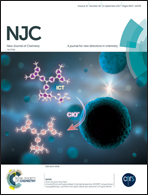β-Configured clickable [18F]FDGs as novel 18F-fluoroglycosylation tools for PET†
Abstract
In oncology and neurology the 18F-radiolabeled glucose analogue 2-deoxy-2-[18F]fluoro-D-glucose ([18F]FDG) is by far the most commonly employed metabolic imaging agent for positron emission tomography (PET). Herein, we report a novel synthetic route to β-configured mannopyranoside precursors and a chemoselective 18F-fluoroglycosylation method that employ two β-configured [18F]FDG derivatives equipped with either a terminal azide or alkyne aglycon respectively, for use as a CuAAC clickable tool set for PET. The β-configured precursors provided the corresponding [18F]FDGs in a radiochemical yield of 77–88%. Further, the clickability of these [18F]FDGs was investigated by click coupling to the suitably functionalized Fmoc-protected amino acids, Fmoc-N-(propargyl)-glycine and Fmoc-3-azido-L-alanine, which provided the 18F-fluoroglycosylated amino acid conjugates in radiochemical yields of 75–83%. The 18F-fluoroglycosylated amino acids presented herein constitute a new and interesting class of metabolic PET radiotracers.
![Graphical abstract: β-Configured clickable [18F]FDGs as novel 18F-fluoroglycosylation tools for PET](/en/Image/Get?imageInfo.ImageType=GA&imageInfo.ImageIdentifier.ManuscriptID=C7NJ00716G&imageInfo.ImageIdentifier.Year=2017)


 Please wait while we load your content...
Please wait while we load your content...